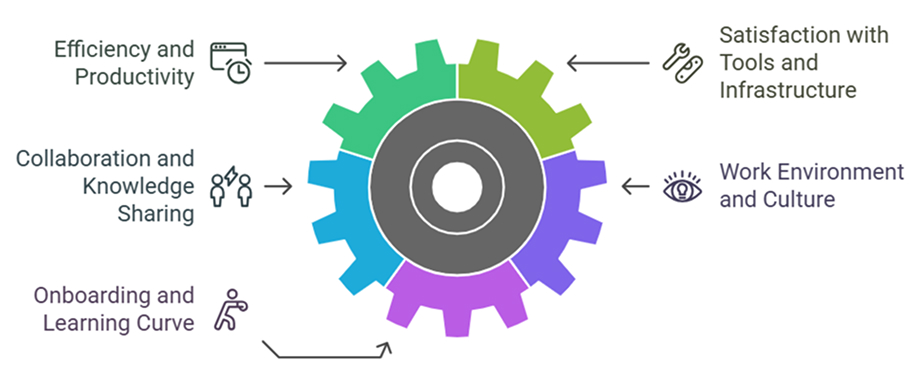Developer Experience Index (DXI)
The developer experience index (DXI) is a new standard that has been developed to measure and enhance the experience of developers in an organization. This primarily revolves around tools, processes, collaboration, and satisfaction. DXI provides insights into developers’ experience at the organization, which can be used to improve the entire development process.

What is the Developer Experience Index (DXI)?
The DXI is a measurement that evaluates the quality of a developer’s experience within an organization. By measuring DXI, project managers can identify pain points and change existing processes and tools. A high DXI score leads to higher productivity, better code quality, and lower turnover rates. At the same time, a low DXI results in frustration, inefficiency, and disengagement.
DXI depends on the following factors:
- Development environment: The development environment includes the technologies, IDEs, and frameworks. Developers should be able to learn new things.
- Build and deployment processes: Consistent and smooth build and deployment processes ensure that developers have a positive experience. CI/CD pipelines should be available for each and every microservice/micro frontend.
- Documentation and onboarding: The onboarding process should be smooth. Based on the existing architecture, design documents should exist for every module.
- Collaboration and communication: All the team members should work as a team.
- Work-life balance: There should be flexibility, and working hours should not be extended after the allocated time. Developers should not have to exhaust themselves, and their mental health should be stable and positive.
Components of DXI

There are several components related to DXI.
- Efficiency and productivity
- DXI depends on the efficiency and productivity of the developer.
- Developers should not spend more time on clarification than on actual coding.
- Manual deployments and slow build times decrease productivity, affecting the overall DXI.
- Satisfaction with tools and infrastructure
- Developers depend on a variety of tools to do their jobs.
- If these tools are not working properly, are difficult to use, or are poorly integrated, the developer experience suffers.
- Collaboration and knowledge sharing
- Effective collaboration is crucial to a positive developer experience.
- The code review and documentation process should be smooth.
- Required knowledge should be provided by the senior developers and leads.
- Work environment and culture
- The work environment should be positive, and developers should be given opportunities to grow in their careers.
- Onboarding and learning curve
- A good DXI framework ensures that new developers can ramp up quickly and contribute effectively.
How to Measure DXI
DXI can be measured using numerous methods.
- Surveys and feedback mechanisms
- Organizations can conduct developer experience surveys.
- In the Agile development process, retrospective meetings can be held to gather insights on developer satisfaction.
- Time tracking and workflow analysis
- Automatic and manual time-tracking tools can be used to analyze the time spent on development and non-development tasks.
- Code review and pull request metrics:
- Analyzing developer efficiency metrics like pull request cycle times and feedback loops can identify communication and collaboration gaps.
- This can identify the number of review cycles, rework percentage, etc.
- Developer retention and turnover rates
- DXI can be measured using the turnover rate.
- A high turnover rate indicates poor developer experience.
Best Practices for Improving DXI
- Set a straightforward documentation and onboarding process. Onboarding is time-consuming, but if there are clear requirements and enhanced guides in place, productivity can increase significantly.
- Promote collaboration and knowledge sharing. Team dynamics improve when mentorship, code reviews, and internal knowledge transfer sessions are common practices.
- Continuous feedback will help improve the developer’s performance, leading to higher satisfaction.
- A good work-life balance directly influences developer productivity metrics. This will ensure long-term engagement and motivation.
Conclusion
The developer experience index (DXI) encapsulates the vital metrics an organization needs to track to enhance the developer experience. It focuses on efficiency, collaboration, tooling, and work-life balance in the workplace and helps raise the red flag on productivity and satisfaction blockers.
With higher DXI, developers produce higher quality codes, work gets done in shorter timeframes, and fewer employees leave the organization. With a lower DXI, the obsession with work increases frustration levels. Organizations can improve DXI by following a refined onboarding process, better documentation, improved CI/CD pipelines, and better teamwork.
When organizations focus on improving the developer experience, it fosters an environment where developers feel great and wish to carry out their responsibilities at their best.